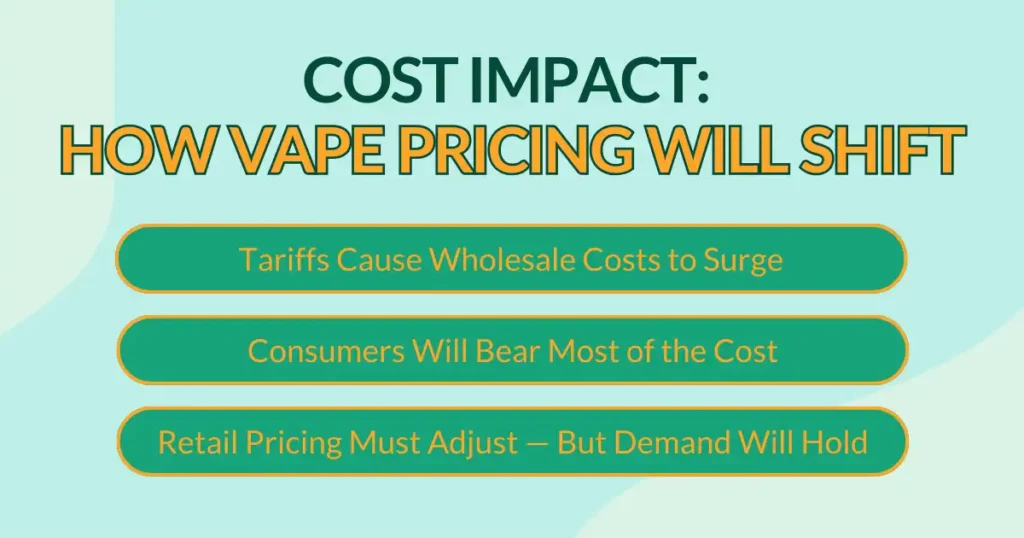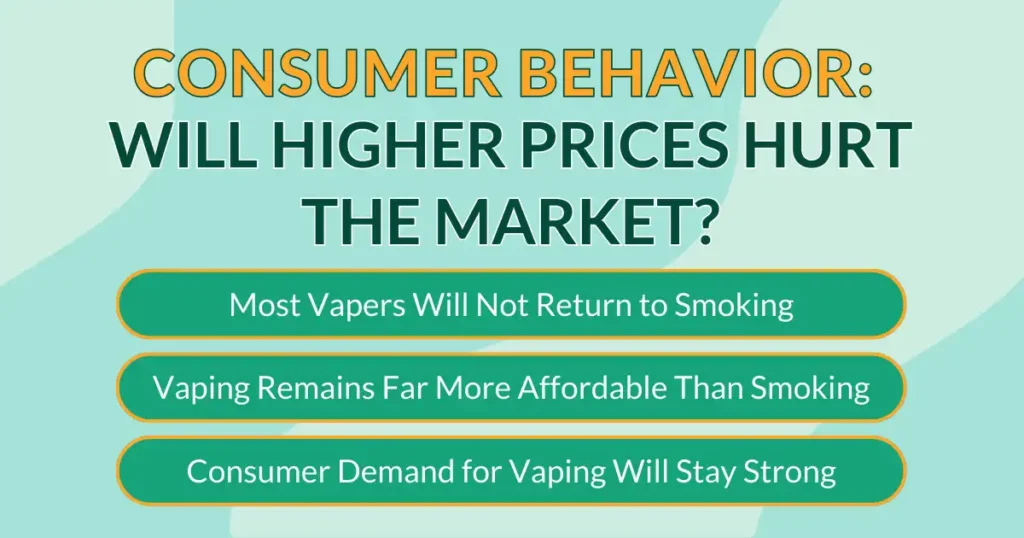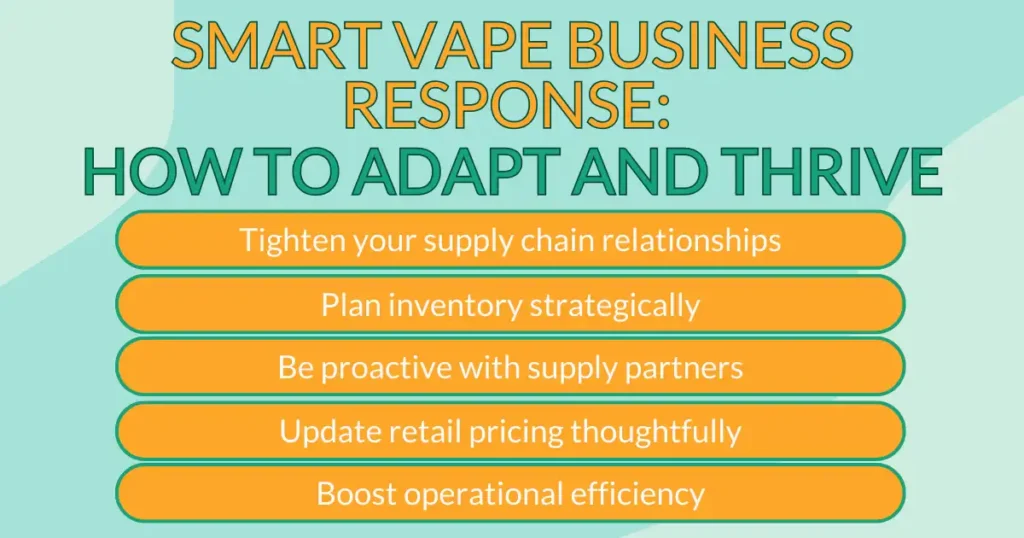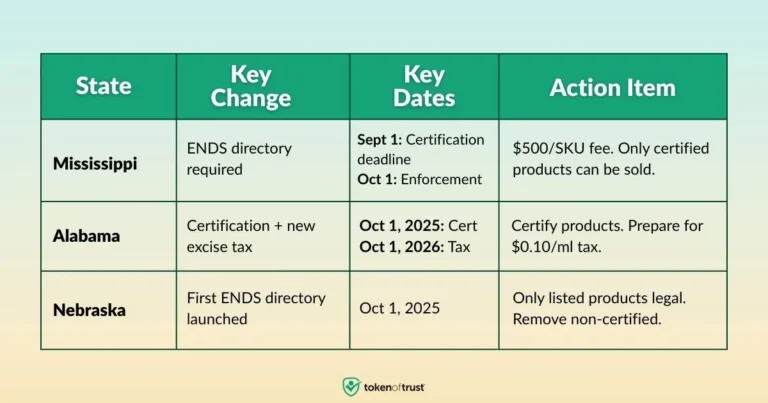China Vape Tariffs in 2025: How Businesses Will Adjust
New vape tariffs in 2025 will create challenges. However, vape businesses can turn these changes into opportunities with the right strategies and partnerships.
With better planning, vape businesses can improve. Stronger supply chain connections will help them adapt. Good compliance support is also important. This way, both B2C and B2B vape businesses can protect their profits and continue to grow.
Understand the new landscape, its effects on your business, and how to adapt.
Tariffs and the Vape Market: What’s Happening
As of April 28, 2025, vape products imported from China are now subject to a total tariff of 170%. This sharp increase stems from the ongoing United States–China trade conflict, combined with recent updates to vape import policies under the Trump administration.
Key facts to understand:
- Wholesale, not retail: These tariffs apply to wholesale pricing — meaning manufacturers, distributors, and B2B merchants will feel the immediate impact, not end consumers at checkout.
- China’s manufacturing dominance: The majority of vape devices sold in the U.S. — including disposables, pods, and mods — are produced in Shenzhen, China, the global hub for vape manufacturing.
- Lack of domestic alternatives: There are virtually no American-made vape devices available at scale, meaning the U.S. vape market cannot easily pivot to domestic production to avoid tariffs.
Bottom line: The supply chain is adjusting, but consumer demand for vape products remains strong.
(For background on previous tariff actions, see the Vaping360 report on vape tariffs).
Tariff Policy Remains Volatile — Don’t Overreact
The Trump administration’s approach to tariffs has been highly inconsistent, with frequent shifts rather than a steady long-term strategy.
As of late April 2025, reports indicate that financial markets and large industries are putting pressure on the administration. This pressure is causing them to reconsider some tariffs on China.
“We’ve already seen signals that tariff policies could shift based on economic conditions,” says Daniel McGee, counsel at Buchanan Ingersoll & Rooney PC. “Business owners should stay nimble and avoid locking themselves into drastic decisions while the situation remains fluid.”
📎 Although vape tariffs are unlikely to disappear overnight, businesses should stay flexible, monitor developments closely, and avoid rushing into major structural changes. A deliberate, informed approach will create better long-term outcomes than reacting out of urgency.
Cost Impact: How Vape Pricing Will Shift

Tariffs will raise the cost of vape products significantly. Here’s a simple example to show the effect:
- Product example: 5-pack of 13ml disposable vapes
- Original Wholesale Cost: $17.50
- Retail Price (Pre-Tariffs): $25.00
New Tariff Impact:
- Tariff adds 145% to the wholesale cost: $25.38
- New landed wholesale cost = $17.50 + $25.38 = $42.88
Note: This does not include state vape excise taxes, which vary by location.
Who absorbs the cost?
The question many vape businesses are asking is: who will bear the burden of these new tariffs?
Through industry conversations, a few trends are clear:
- Manufacturers, distributors, and B2B vape merchants may share some of the added costs through pricing adjustments and negotiations.
- However, in most cases, the majority of the cost increase will flow to consumers at the retail level.
While businesses across the supply chain may absorb small portions to stay competitive, the overall market expectation is that end customers will ultimately pay more for vape products.
This reality makes transparent pricing strategies and clear customer communication even more important as businesses adapt to the new environment.
Retail pricing strategies will need to evolve — but the consumer market will remain loyal.
Consumer Behavior: Will Higher Prices Hurt the Market?

Many vape businesses are concerned that rising vape product prices could drive customers back to traditional cigarettes. However, recent research suggests this risk is minuscule.
A 2023 study in BMC Public Health looked at how price increases change consumer behavior. It found that even if vaping costs doubled, only 2–3% of consumers would switch back to smoking.
Even with higher costs from tariffs and taxes, vaping remains far more attractive than smoking for most consumers. Vape businesses can feel confident that demand for vape products will remain strong in 2025 and beyond.
Cost Comparison: Vaping vs Smoking
Even with higher tariffs and taxes, vaping remains significantly more affordable than smoking.
Vaping Costs:
- 5 disposables (around 5,000 puffs each) deliver roughly 25,000 total puffs.
- After tariffs and excise taxes, the retail cost for these devices is about $60–$70.
Smoking Costs:
- A cigarette offers around 10 puffs, meaning a vaper would need approximately 2,500 cigarettes to match the same usage.
- 2,500 cigarettes equal 125 packs.
- At an average of $10–$12 per pack, the total cost would be between $1,250 and $1,500.
What this means:
Despite price increases from tariffs and taxes, vaping is still dramatically cheaper than smoking.
Consumers have strong reasons to continue choosing vaping — they will simply seek the best value within the vaping category rather than returning to cigarettes.
Smart Vape Business Response: How to Adapt and Thrive

The vape businesses that will succeed aren’t the ones who panic — they’re the ones who adjust with a clear plan.
Here’s how:
1. Tighten supply chain relationships:
Build stronger partnerships with Chinese manufacturers. Focus on optimizing pricing, invoicing, and shipping schedules to manage costs more effectively.
2. Plan inventory strategically:
Prioritize high-velocity, proven best-sellers. Avoid over-investing in slow-moving or experimental products that could tie up cash and increase tariff exposure. In a high-tariff environment, lean, fast-turning inventories are critical.
3. Be proactive with supply partners:
U.S. wholesalers and B2B vape businesses should revisit terms where possible. Strategies include:
- Reducing minimum order quantities (MOQs)
- Requesting flexible pricing based on landed costs
- Exploring alternative device formats that may lower tariff impact
4. Update retail pricing thoughtfully:
Communicate changes clearly to customers. Reinforce vaping’s cost advantages compared to smoking, promote longer-lasting devices, and strengthen loyalty programs to retain customer trust.
5. Boost operational efficiency:
Tighten internal margins where possible without sacrificing product quality. Every percentage point of efficiency gained can help offset increased costs.
Facing industry changes in 2025?
Partner with Token of Trust to build a stronger, compliance-focused vape business.
[Explore Vape Compliance Solutions →]
Compliance: Building a Stronger Vape Business Foundation
Strong compliance isn’t just about avoiding fines, it’s what keeps a vape business moving forward.
As regulations tighten, businesses need to meet key requirements, including:
- Paying vape excise taxes at both the state and federal levels
- Managing full PACT Act compliance — shipping reports, tax registrations, and detailed reporting
Staying compliant protects your brand, preserves customer trust, and positions your business to grow, despite industry changes.
Token of Trust makes it easier. Our compliance solutions help vape businesses stay ahead, stay legal, and stay focused on growth.
[Explore Vape Compliance Services →]
Stay Flexible and Stay Informed
With tariffs changing quickly, vape businesses need to stay alert and ready to adapt.
Key steps to stay ahead:
- Stay connected with industry groups like SFATA for updates and advocacy.
- Follow reliable news sources that track regulatory changes and market shifts.
- Keep cash flow and inventory flexible to adjust quickly if conditions change.
Agility isn’t optional — it’s a competitive advantage. The businesses that stay informed and adjust fast will lead the market as conditions change.
Build a Stronger Vape Business with Token of Trust
At Token of Trust, we help vape businesses turn regulatory challenges into growth opportunities. Our vape compliance services are built to protect your business, strengthen operations, and support growth in a changing market.
How we can help:
- Tariff impact management to control costs and optimize your supply chain.
- Vape excise tax compliance support across federal and state jurisdictions.
- PACT Act registration and reporting to simplify shipping and tax reporting.
- Compliance consulting to keep you ahead as vape regulations evolve.
Compliance drives growth. Let’s build a stronger, future-ready vape business.
[Schedule Your Compliance Consultation →]






